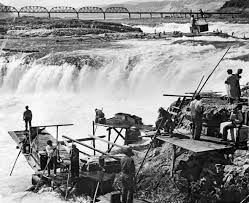CELILO
CATEGORY: GRASS VALLEY
PHOTO: INDIANS FISHING AT CELILO FALLS (Note man in cable box at top right)

Whenever we drove from Grass Valley to The Dalles, we drove past Celilo, an Indian village on the Colombia River. Celilo Village was right beside Celilo Falls where the whole of the powerful Colombia River thundered over a cliff and where the Indians precariously fished for salmon with nets. They stood on rickety wooden platforms tacked to the vertical rocks by God knows what means–probably with Scotch tape or thumb tacks. They rode in small box-like carts, hanging from cables over the top of the falls, to even more precarious rock outcroppings in the middle of the plunging water.
The village was seasonal, being inhabited only during salmon runs. It was an extensive conglomeration of shacks thrown together using old boards that looked like they had been scavenged from river drift wood. These structures were actually just shelters from the sun or rain and, like the fishing platforms, were held together by dubious means; they had neither doors, windows nor floors.
When the salmon were running we would stop at Celilo to buy a whole fish to take home and roast in my mother’s especially flavorful way. Sometimes we children got out of the car and stood awkwardly absorbing this strange scene. We could look right into the shelters since, along with the afore mentioned lack of amenities, many of them had no walls. Once I saw a barefooted little girl in a raggedy dress staring back at me out of the shadows. She came hesitantly out into the light, and I saw that the blacks of her eyes were clouded over with wisps of white. I wondered if she were blind, or nearly so.
After that I noticed that many of the Indians that we saw on the sidewalks or in the shops in The Dalles had the same white substance partially covering the irises of their eyes. It made me feel like crying for them. I never did find out what this affliction was or what caused it.
In 1938 Bonneville Dam was completed, partially covering the falls. The Indians still fished there but the fishing was not as good. Then in 1957 The Dalles Dam was completed, just upstream from The Dalles and downstream from Celilo. The result was that Celilo Falls became completely covered with water. For compensation, the federal government built houses for the Indians with real roofs, windows, doors, plumbing and electricity (even walls) across the highway from the river. What a waste of money! Why would the Indians want to live there when their reason for being there at all was to catch Salmon? Most of those houses were never inhabited. It was a sad day for the Indians when they could no longer fish at Celilo. It had been their fishing grounds since time immemorial.
When Lewis and Clark came down the Colombia in 1805, they reported that the Indians had a flourishing industry at the falls. They said that there were identical sized rectilinear willow baskets lined with salmon skin, filled with dried, flaked salmon and covered over the top with more salmon skin plus a basket lid hinged with tied raw-hide hinges. These baskets were stacked shoulder high and covered a large area. Indians from many miles away came there to trade for salmon. It was an important center for all Northwest Indians. Not only did the white man take the land away from the Indians in the early days, but even in 1957 they were still taking – in this case, the Indian’s fishing rights. For those Indians, The Dalles Dam was the end of a very long and important era. For us, it was the end of having the most delicious roast salmon that anyone ever ate.
